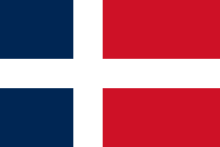Flag of the Saarland
The state flag of the Saarland consists of the federal flag , on it in the middle, overlapping in the black and gold-colored stripes, the state coat of arms of the Saarland , the right side (from the viewer's point of view the left side) turned towards the mast (hoisting flag). It can also be designed as a banner flag, then the stripes are arranged vertically, the coat of arms is upright, the right side (from the viewer's point of view the left side) turned towards the black stripe.
Meaning and use
According to the Saarland constitution, the state colors have been black, red and gold since 1957 . This combination was chosen after the accession of the Saarland to the Federal Republic of Germany, in order to demonstrate demonstratively that the Saarland belongs to Germany.
use
Although the flag contains the state coat of arms, the state flag can be used by every state citizen (in contrast to other state flags with coats of arms such as Berlin or Baden-Württemberg ).
Standard
The President of the State Parliament and the Prime Minister have the right to decorate their vehicles with their own standard ("car flag") on special occasions . The ministers and the heads of the state authorities are also allowed to use car standards, but these are miniaturized versions of the national flag (ministers: 25 × 25 cm; heads of authorities: 18 × 25 cm).
Old country flags
1919-1935
After the separation of the Saar area from the German Empire by the provisions of the Versailles Treaty , the state flag consisted of a blue-white-black tricolor. These are both the colors of the two former states of Prussia (black and white) and Bavaria (white and blue), from parts of whose areas the Saar area was formed, as well as the basic colors of the individual coat of arms fields of the coat of arms of the Saar area from July 28, 1920.
1947-1956
At the time of the Saar state after the Second World War , the Saarland flag consisted of a silver (white) Scandinavian cross , the background to the mast blue, to the other side red (Articles 61 and 62 of the Saarland constitution). The combination of colors could be interpreted as a reference to the French tricolor or to the colors of the important historical territories in the Saar region, namely white-red for Kurtrier and white-blue for the Kurpfalz . The cross itself was intended to symbolize the Christian character of the entire social life in Saarland after the collapse of National Socialism , without this having been expressly formulated in an official statement of legal status.
Trivia
The flag of the Saar area from 1919 to 1935 is similar to the current flag of Estonia . For even more similarity to the Saar flag have the in 1806, through which the ribbon Bavarian King I. Maximilian Joseph donated Bavarian Military Max Joseph Order, and the ribbon of the Bavarian Military Merit , which in 1866 by the Bavarian King Ludwig II. Was donated was. The Saarland flag from 1948 to 1956 is very similar to the historic flag of the Dominican Republic until 1844.
See also
- History of the Saarland
- State coat of arms of the Saarland
- List of coats of arms in Saarland
- Saarland Order of Merit
literature
- Kurt Hoppstädter: The coat of arms of the Saarland . Saarbrücken 1953.
- Hermann Lehne, Horst Kohler: coat of arms of the Saarland. State and municipal coats of arms . Saarbrücken 1981.
Individual evidence
- ↑ Car Flags for Authorities 1956-2001 (Saar, Germany) (English)
- ^ Kurt Hoppstädter: The coat of arms of the Saarland , Part I. Ed .: Historical Association for Saarland e. V. in cooperation with the state archive of the Saarland government. In: Journal for Saarland local history , 3rd year, issue 1–4, Saarbrücken 1953, pp. 13–14.
- ↑ The Constitution of the Saarland, With the Conventions on Tax, Budget and Justice, Saarbrücken 1948, p. 30: Art. 61: "The flag of the state consists of a white cross on a blue-red background." Art. 62 : "The details about this, as well as the state coat of arms, are determined by a law."
- ^ Rolf Wittenbrock: … You holy land on the Saares beach, denominational school and search for identity . In: From “Hour 0” to “Day X”, Das Saarland 1945-59 . Catalog for the exhibition of the Regional History Museum in Saarbrücken Castle. Saarbrücken 1990, pp. 257-272, here: p. 267.



